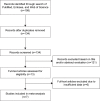Increased programmed death ligand-1 expression predicts poor prognosis in hepatocellular carcinoma patients
- PMID: 27536144
- PMCID: PMC4976917
- DOI: 10.2147/OTT.S110713
Increased programmed death ligand-1 expression predicts poor prognosis in hepatocellular carcinoma patients
Abstract
Purpose: Accumulating studies have investigated the prognostic and clinical significance of programmed death ligand-1 (PD-L1) expression in patients with hepatocellular carcinoma (HCC); however, the results were conflicting and inconclusive. We conducted a meta-analysis to combine controversial data to precisely evaluate this issue.
Methods: Relevant studies were thoroughly searched on PubMed, Web of Science, and Embase until April 2016. Eligible studies were evaluated by selection criteria. Hazard ratio (HR) with 95% confidence interval (CI) was used to estimate the prognostic role of PD-L1 for overall survival (OS) and disease-free survival (DFS)/recurrence-free survival (RFS). Odds ratio (OR) with 95% CI were selected to assess the relationship between PD-L1 and clinicopathological features of HCC patients. Publication bias was tested using Begg's funnel plot.
Results: A total of seven studies published from 2009 to 2016 were included for meta-analysis. The data showed that high PD-L1 expression was correlated to shorter OS (HR =2.09, 95% CI: 1.66-2.64, P<0.001) as well as poor DFS/RFS (HR =2.3, 95% CI: 1.46-3.62, P<0.001). In addition, increased PD-L1 expression was also associated with tumor differentiation (HR =1.51, 95% CI: 1-2.29, P=0.05), vascular invasion (HR =2.16, 95% CI: 1.43-3.27, P<0.001), and α-fetoprotein (AFP; HR =1.46, 95% CI: 1-2.14, P=0.05), but had no association with tumor stage, tumor size, hepatitis history, sex, age, or tumor multiplicity. No publication bias was found for all analyses.
Conclusion: This meta-analysis revealed that overexpression of PD-L1 was predictive for shortened OS and DFS/RFS in HCC. Furthermore, increased PD-L1 expression was associated with less differentiation, vascular invasion, and AFP elevation.
Keywords: hepatocellular carcinoma; meta-analysis; prognosis; programmed death ligand-1.
Figures



Similar articles
-
Clinicopathologic Significance and Prognostic Value of Programmed Cell Death Ligand 1 (PD-L1) in Patients With Hepatocellular Carcinoma: A Meta-Analysis.Front Immunol. 2018 Sep 11;9:2077. doi: 10.3389/fimmu.2018.02077. eCollection 2018. Front Immunol. 2018. PMID: 30254644 Free PMC article.
-
Prognostic value of programmed cell death ligand 1 (PD-L1) for hepatocellular carcinoma: a meta-analysis.Biosci Rep. 2020 Apr 30;40(4):BSR20200459. doi: 10.1042/BSR20200459. Biosci Rep. 2020. PMID: 32255189 Free PMC article.
-
Prognostic and clinicopathological value of PD-L1 in colorectal cancer: a systematic review and meta-analysis.Onco Targets Ther. 2019 May 14;12:3671-3682. doi: 10.2147/OTT.S190168. eCollection 2019. Onco Targets Ther. 2019. PMID: 31190869 Free PMC article. Review.
-
Prognostic Value of Programmed Cell Death Ligand-1 Expression in Nasopharyngeal Carcinoma: A Meta-Analysis of 1,315 Patients.Front Oncol. 2019 Oct 25;9:1111. doi: 10.3389/fonc.2019.01111. eCollection 2019. Front Oncol. 2019. PMID: 31709181 Free PMC article.
-
Prognostic role of PD-L1 for HCC patients after potentially curative resection: a meta-analysis.Cancer Cell Int. 2019 Jan 29;19:22. doi: 10.1186/s12935-019-0738-9. eCollection 2019. Cancer Cell Int. 2019. PMID: 30718977 Free PMC article.
Cited by
-
The Prognostic Value of Plasma Programmed Death Protein-1 (PD-1) and Programmed Death-Ligand 1 (PD-L1) in Patients with Gastrointestinal Stromal Tumor.Cancers (Basel). 2022 Nov 23;14(23):5753. doi: 10.3390/cancers14235753. Cancers (Basel). 2022. PMID: 36497235 Free PMC article.
-
Hepatocellular Carcinoma: Current Therapeutic Algorithm for Localized and Advanced Disease.J Oncol. 2022 Dec 31;2022:3817724. doi: 10.1155/2022/3817724. eCollection 2022. J Oncol. 2022. PMID: 36624801 Free PMC article. Review.
-
How does the tumor microenvironment play a role in hepatobiliary tumors?J Gastrointest Oncol. 2018 Feb;9(1):180-195. doi: 10.21037/jgo.2017.06.09. J Gastrointest Oncol. 2018. PMID: 29564184 Free PMC article. Review.
-
CLEC1B Expression and PD-L1 Expression Predict Clinical Outcome in Hepatocellular Carcinoma with Tumor Hemorrhage.Transl Oncol. 2018 Apr;11(2):552-558. doi: 10.1016/j.tranon.2018.02.010. Epub 2018 Mar 8. Transl Oncol. 2018. PMID: 29525632 Free PMC article.
-
Approaches for Detection of Hepatitis B Virus Pre-S Gene Deletions and Pre-S Deleted Proteins and Their Application in Prediction of Higher Risk of Hepatocellular Carcinoma Development and Recurrence.Viruses. 2022 Feb 18;14(2):428. doi: 10.3390/v14020428. Viruses. 2022. PMID: 35216021 Free PMC article. Review.
References
-
- Torre LA, Bray F, Siegel RL, Ferlay J, Lortet-Tieulent J, Jemal A. Global cancer statistics, 2012. CA Cancer J Clin. 2015;65(2):87–108. - PubMed
-
- Forner A, Llovet JM, Bruix J. Hepatocellular carcinoma. Lancet. 2012;379(9822):1245–1255. - PubMed
-
- Goodgame B, Shaheen NJ, Galanko J, El-Serag HB. The risk of end stage liver disease and hepatocellular carcinoma among persons infected with hepatitis C virus: publication bias? Am J Gastroenterol. 2003;98(11):2535–2542. - PubMed
LinkOut - more resources
Full Text Sources
Other Literature Sources
Research Materials
Miscellaneous

